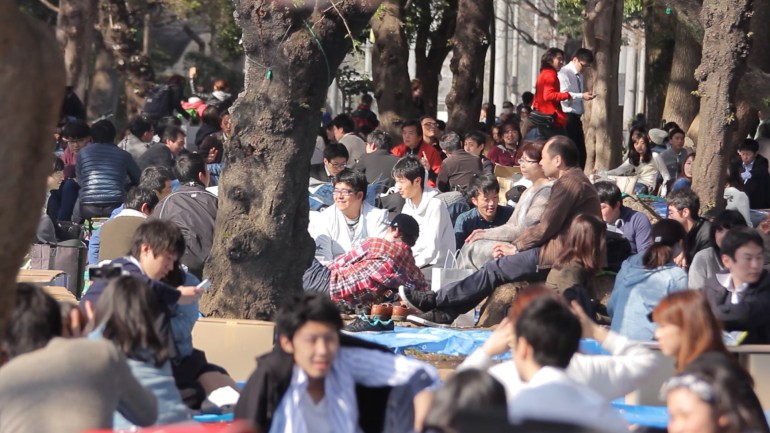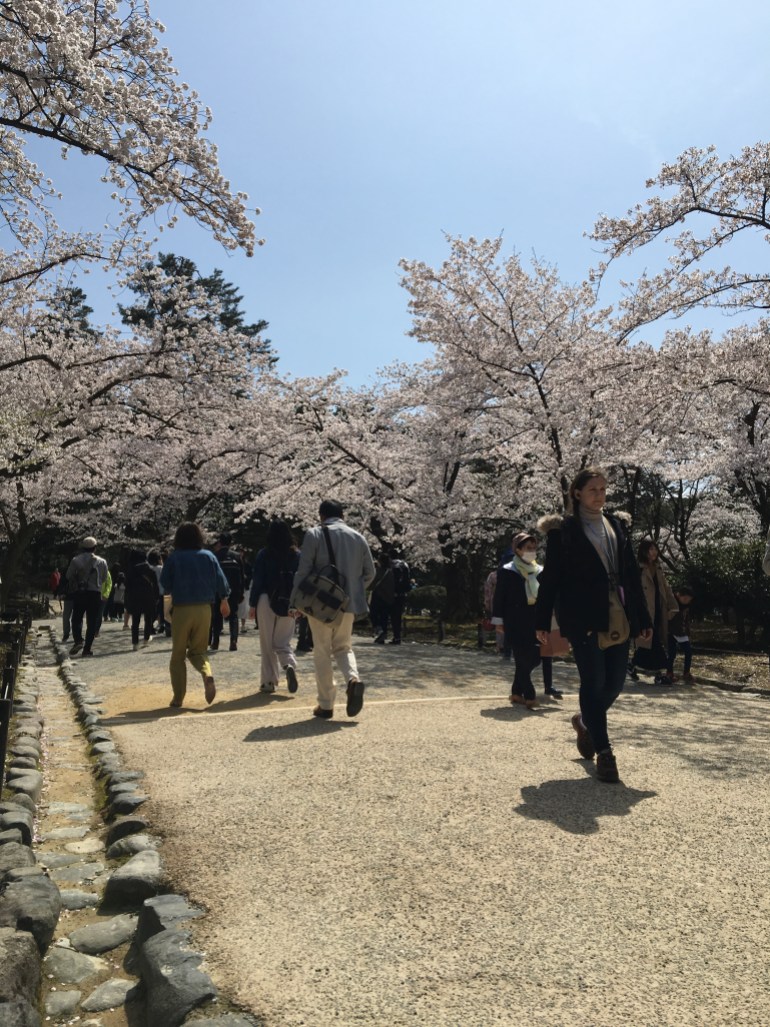COVID-19 takes spring out of Japan’s ‘hanami’ season | Arts and Culture News
Tokyo, Japan – Cherry blossom viewing, called “hanami” in the Japanese language, is one of the most iconic and beloved traditions of the East Asian nation, but this year the continuing COVID-19 pandemic is putting a damper on this year’s festivities.
The custom is believed to have taken root in Japan about 1,200 years ago, and today viewing the sakura, or cherry blossoms, is one of the most eagerly awaited periods of the year.
News reports about when and where the pale pink flowers will emerge from the branches are zealously followed by many Japanese – peak hanami is forecast to take place in Tokyo on March 22 this year – and numerous local artistic motifs are built around the arrival of spring and what is seen as a joyous season.
While hanami is certainly an effective symbol of Japanese cultural refinement, it is also a time when families and friends gather outside to enjoy themselves amid the blossoms.
In major parks in Tokyo and other urban areas, hanami zones are often overrun with visitors during the high season. Picnic blankets cover the grass, and loud drunken conversations fill the air among the massed crowds. Nearby rubbish bins overflow with the unsightly leftover packaging of boxed lunches, plastic cups, and much more.
 Japan’s hanami season usually means crowds of people enjoying picnics beneath the blossoms as they celebrate the arrival of spring [Michael Penn/Al Jazeera]
Japan’s hanami season usually means crowds of people enjoying picnics beneath the blossoms as they celebrate the arrival of spring [Michael Penn/Al Jazeera]Given the continuing outbreak of the coronavirus, the authorities, worried about the potential risk for further spread, have tried to establish firm limits on the celebrations this year.
Earlier this month, Tokyo Governor Yuriko Koike declared, “I’m very sorry about this year’s hanami, but I’d like to ask people to go without it.”
The main thrust of the governor’s policy is to implement a ban on people eating and drinking in public parks during the hanami season although there is some variation in how the policy is being enforced.
Keep moving
Tokyo’s Yoyogi Park has blocked off all public access for nearly a month to its sakura garden and its central square area while Ueno Park has established barriers creating one-way lanes for pedestrians. Visitors are welcome to enjoy hanami, but only if they keep walking.
Similarly, the more suburban Inokashira Park has strung up bright orange barriers to keep people away from the benches and the most scenic spots along its lake, lest the ocular delights tempt rebellious souls to linger too long.
Noriko Naito, a general manager and public relations officer for the Tokyo Metropolitan Government, told Al Jazeera English that this year “many more people will be enjoying hanami at their homes by buying cherry blossom bonsai,” referring to the traditional potted, miniaturised trees common in Japan.
She also said that people do not really need to go to the parks to see the blossoms since they are all over Japan.
“Even at the entrance of my apartment there is a very large cherry blossom tree,” she observes.
Much of the general public seems ready to comply.
 The flowering of the spring blossoms is eagerly awaited in Japan, which has an official hanami forecast, with peak hanami predicted for Tokyo on March 22 this year [Kate Mayberry/Al Jazeera]
The flowering of the spring blossoms is eagerly awaited in Japan, which has an official hanami forecast, with peak hanami predicted for Tokyo on March 22 this year [Kate Mayberry/Al Jazeera]An opinion poll conducted by the firm, Kakuyasu, and published last week, found that while about 72 percent of the respondents say they usually or always enjoy hanami in the spring season, this year only 32 percent are planning to stick with their custom.
Almost 23 percent answered that they still want to go out to view the blossoms, but have opted to exercise personal restraint for this year.
“So far I have zero invitations,” said Tokyo office worker Kasumi Hirokawa, “I think everyone is being careful and staying home as much as possible.”
She adds: “I will try to make an effort to go out and walk around my neighbourhood, because there’s a little stream in front of my apartment with a row of sakura trees on both sides.”
Of course, not all Japanese live in Tokyo, and many regional and rural areas are taking a more relaxed policy toward hanami.
Virtual viewing
Aki Yoshida, a part-time English teacher, lives on the northern island of Hokkaido, where the blossoms usually bloom several weeks later than in other parts of Japan.
Yoshida recalls that she mainly used to participate in the parties back when she was a university student.
In Hokkaido, the standard cultural practices are somewhat different from Tokyo. Rather than a boxed lunch, Japanese in this region customarily view blossoms while gathered around a hot grill cooking strips of lamb meat, known locally as a “Chinggis Khan barbecue”.
 Kanazawa’s Kenrokuen Garden, said to be one of the best traditional gardens in Japan, is a popular place to enjoy the spring blossoms [File: Kate Mayberry/Al Jazeera]
Kanazawa’s Kenrokuen Garden, said to be one of the best traditional gardens in Japan, is a popular place to enjoy the spring blossoms [File: Kate Mayberry/Al Jazeera]The pandemic, however, will not greatly affect Yoshida, who usually limits herself to viewing the sakura while walking down the avenues.
She believes that, even with the official state of emergency having been lifted, people in the Tokyo region should still refrain from going out and holding any hanami parties.
“Last year,” she pointed out, “the number of infected people increased dramatically in April, in hanami season. I think we should not repeat that same mistake.”
She advises that those who really need to scratch their blossom-viewing itch might try the alternative of “virtual hanami” instead.
Indeed, while it has not yet been popularised, some efforts are under way to create a virtual hanami experience for the Japanese public.
For example, the official “Uenon Channel” has been created on YouTube in which Ueno Park’s official mascot character – Uenon – guides viewers through the park’s delights, wordlessly but set to a music soundtrack.
Billboards have been set up in the park promoting the YouTube channel and offering a QR code to guide people to its address.
Some television programmes have also been educating their viewers about various options to track the blossoms from the computerised comfort of their homes.
While not everyone is expected to cooperate with the authorities’ requests to avoid hanami parties, most Japanese in the crowded urban areas do seem to have gotten the message that, as much as they may love the blossoms, spring will come again in future years.
“I just hope everyone will stay safe and for the pandemic to be behind us,” said Hirokawa, the Tokyo office worker.
